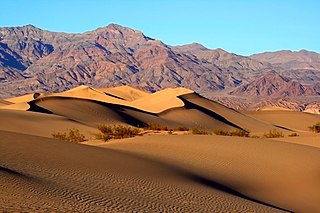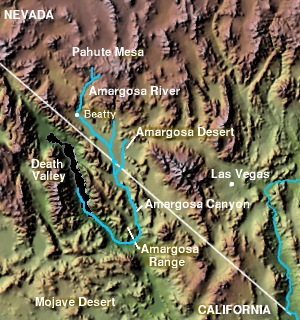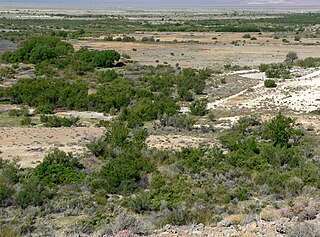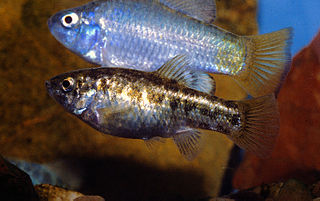Related Research Articles

The Mojave Desert is a desert in the rain shadow of the southern Sierra Nevada mountains and Transverse Ranges in the Southwestern United States. It is named for the indigenous Mojave people. It is located primarily in southeastern California and southwestern Nevada, with small portions extending into Arizona and Utah.

The Death Valley pupfish, also known as Salt Creek pupfish, is a small species of fish in the family Cyprinodontidae found only in Death Valley National Park, California, United States. There are two recognized subspecies: C. s. salinus and C. s. milleri. The Death Valley pupfish is endemic to two small, isolated locations and currently classified as endangered.

The Amargosa Valley is the valley through which the Amargosa River flows south, in Nye County, southwestern Nevada and Inyo County in the state of California. The south end is alternately called the "Amargosa River Valley'" or the "Tecopa Valley." Its northernmost point is around Beatty, Nevada and southernmost is Tecopa, California, where the Amargosa River enters into the Amargosa Canyon.

The Tecopa pupfish is an extinct subspecies of the Amargosa pupfish. The small, heat-tolerant pupfish was endemic to the outflows of a pair of hot springs in the Mojave Desert of California. Habitat modifications and the introduction of non-native species led to its extinction in about 1970.
The Shoshone pupfish is a subspecies of Cyprinodon nevadensis from California in the United States. It is characterized by large scales and a "slab-sided," narrow, slender body, with the arch of the ventral contour much less pronounced than the dorsal. It also has fewer pelvic fin rays and scales than the other subspecies of C. nevadensis.

The Ash Meadows National Wildlife Refuge is a protected wildlife refuge located in the Amargosa Valley of southern Nye County, in southwestern Nevada. It is directly east of Death Valley National Park, and is 90 mi (140 km) west-northwest of Las Vegas.

The Devils Hole pupfish is a critically endangered species of the family Cyprinodontidae (pupfishes) found only in Devils Hole, a water-filled cavern in the US state of Nevada. It was first described as a species in 1930 and is most closely related to C. nevadensis and the Death Valley pupfish. The age of the species is unknown, with differing analyses offering ranges between one thousand and sixty thousand years. It is a small fish, with maximum lengths of up to 30 mm (1.2 in). Individuals vary in coloration based on age and sex: males are bright metallic blue while females and juveniles are more yellow. A defining trait of this species is its lack of pelvic fins. The pupfish consumes nearly every available food resource at Devils Hole, including beetles, snails, algae, and freshwater crustaceans, with diet varying throughout the year. It is preyed on by the predaceous diving beetle species Neoclypeodytes cinctellus, which was first observed in Devils Hole in 1999 or 2000. Reproduction occurs year-round, with spikes in the spring and fall. Females produce few eggs, though, and the survivorship from egg to adult is low. Individuals live 10–14 months.

The Amargosa Desert is located in Nye County in western Nevada, United States, along the California–Nevada border, comprising the northeastern portion of the geographic Amargosa Valley, north of the Ash Meadows National Wildlife Refuge.

Pupfish are a group of small killifish belonging to ten genera of the family Cyprinodontidae of ray-finned fish. Pupfish are especially noted for being found in extreme and isolated situations. They are primarily found in North America, South America, and the Caribbean region, but Aphanius species are from southwestern Asia, northern Africa, and southern Europe. As of August 2006, 120 nominal species and 9 subspecies were known. Several pupfish species are extinct and most extant species are listed. In the U.S., the most well-known pupfish species may be the Devil's Hole Desert Pupfish, native to Devil's Hole on the Nevada side of Death Valley National Park. Since 1995 the Devil's Hole Pupfish has been in a nearly steady decline, where it was close to extinction at 35–68 fish in 2013.

Devils Hole is a geologic formation located in a detached unit of Death Valley National Park and surrounded by the Ash Meadows National Wildlife Refuge, in Nye County, Nevada, in the Southwestern United States.

Cyprinodon is a genus of pupfishes found in waters that range from fresh to hypersaline. The genus is primarily found in Mexico, the Caribbean Islands and southern United States, but C. variegatus occurs as far north as Massachusetts and along the entire Gulf of Mexico coastline, and C. dearborni and C. variegatus are found in northern South America. Many species have tiny ranges and are highly threatened, in some cases already extinct. Cyprinodon are small; the largest reaches 10 cm (3.9 in) in length and most other species only reach about half that size.
Robert Rush Miller "was an important figure in American ichthyology and conservation from 1940 to the 1990s."
Cyprinodon ceciliae is an extinct species of pupfish. It was endemic to the Ojo de Agua la Presa in southwestern Nuevo Leon state in Mexico, but disappeared in 1990 due to habitat loss. The same freshwater spring system was the home of three other pupfish: Cyprinodon inmemoriam (extinct), Cyprinodon longidorsalis and Cyprinodon veronicae. Although these were from the same spring system, each was restricted to its own individual spring and associated waters. The exact spring and associated waters inhabited by the Villa Lopez pupfish were also the home of a now-extinct, undescribed species of Cambarellus crayfish. The specific name honours the daughter of María de Lourdes Lozano-Vilano and niece of Salvador Contreras-Balderas, Cecilia Contreras Lozano, who assisted on the trip on which the type was collected.

The Owens pupfish is a rare species of fish in the family Cyprinodontidae, the pupfish. It is endemic to California in the United States, where it is limited to the Owens Valley. It is a federally listed endangered species of the United States. This pupfish is up to 5 centimetres long, the largest males sometimes longer. The male is blue-gray, turning bright blue during spawning. The female is greenish brown with a silvery or whitish belly.
The Guzmán Basin is an endorheic basin of northern Mexico and the southwestern United States. It occupies the northwestern portion of Chihuahua in Mexico, and extends into southwestern New Mexico in the United States.

The desert pupfish is a rare species of bony fish in the family Cyprinodontidae. It is a small fish, typically less than 7.62 cm (3 in) in length. Males are generally larger than females, and have bright-blue coloration, while females and juveniles are silvery or tan. A notable attribute of the desert pupfish is their ability to survive in environments of extreme salinity, pH, and temperature, and low oxygen content. The desert pupfish mates in a characteristic fashion, wherein compatible males and females will come in contact and collectively jerk in an s-shape. Each jerk typically produces a single egg that is fertilized by the male and deposited in his territory. Breeding behavior includes aggressive arena-breeding and more docile consort-pair breeding.
The Saratoga Springs pupfish is a subspecies of the Amargosa pupfish of the family Cyprinodontidae. The native population is endemic to Saratoga Springs, a small wetland in Death Valley National Park in the United States.

Cyprinodon nevadensis is a species of pupfish in the genus Cyprinodon. The species is also known as the Amargosa pupfish, but that name may also refer to one subspecies, Cyprinodon nevadensis amargosae. All six subspecies are or were endemic to very isolated locations in the Mojave Desert of California and Nevada.

Lake Manly was a pluvial lake in Death Valley, California, covering much of Death Valley with a surface area of 1,600 square kilometres (620 sq mi) during the so-called "Blackwelder stand". Water levels varied through its history, and the chronology is further complicated by active tectonic processes that have modified the elevations of the various shorelines of Lake Manly; during the Blackwelder stage they reached 47–90 metres (154–295 ft) above sea level. The lake received water mainly from the Amargosa River and at various points from the Mojave River and Owens River. The lake and its substantial catchment favoured the spread of a number of aquatic species, including some lizards, pupfish and springsnails. The lake probably supported a substantial ecosystem, and a number of diatoms developed there.

The Amargosa River pupfish is a member of a pupfish species complex which inhabits the watershed of ancient Lake Manly. Currently, the species inhabits two disjunct perennial reaches of the lower Amargosa River. The upstream portion is near Tecopa and passes through the Amargosa Canyon. The lower portion is northwest of Saratoga Springs, just at the head of Death Valley, where the Amargosa River turns north to enter the valley.
References
- ↑ Abell, Robin A. (2000). "Appendix G. Ecoregion Descriptions. Ecoregion 11. Death Valley". Freshwater Ecoregions of North America: A Conservation Assessment. Island Press. p. 177. ISBN 978-1-55963-734-3.
- 1 2 3 4 5 "Death Valley". Freshwater Ecoregions of the World. Retrieved 17 September 2021.